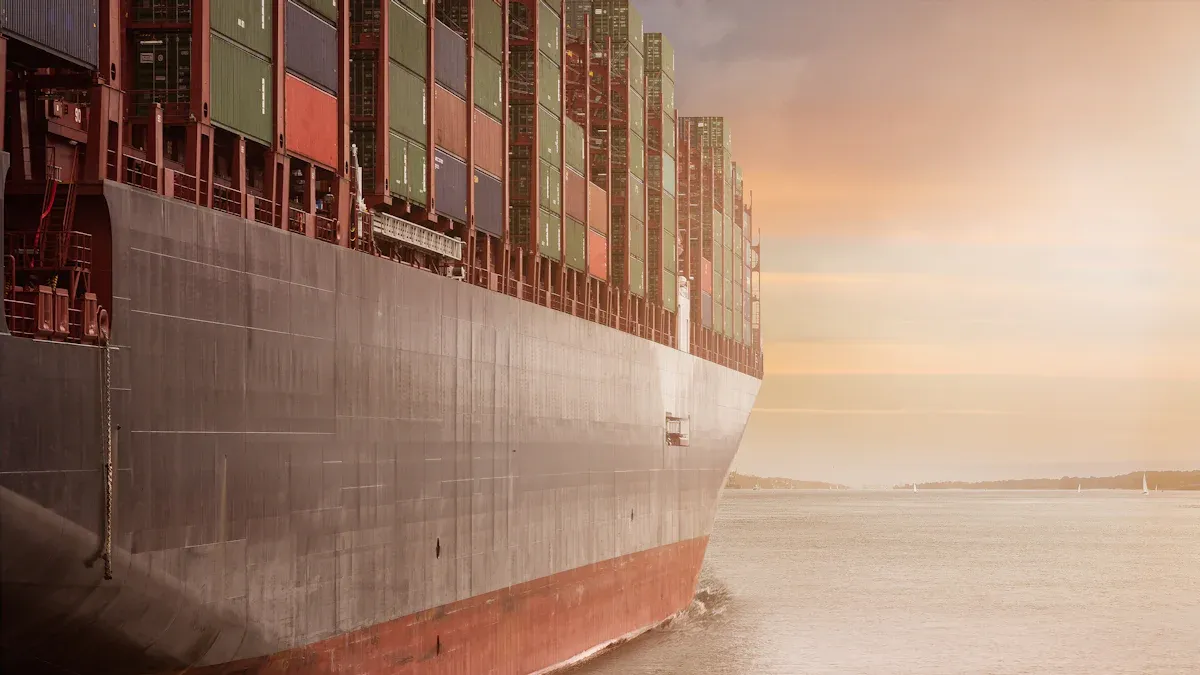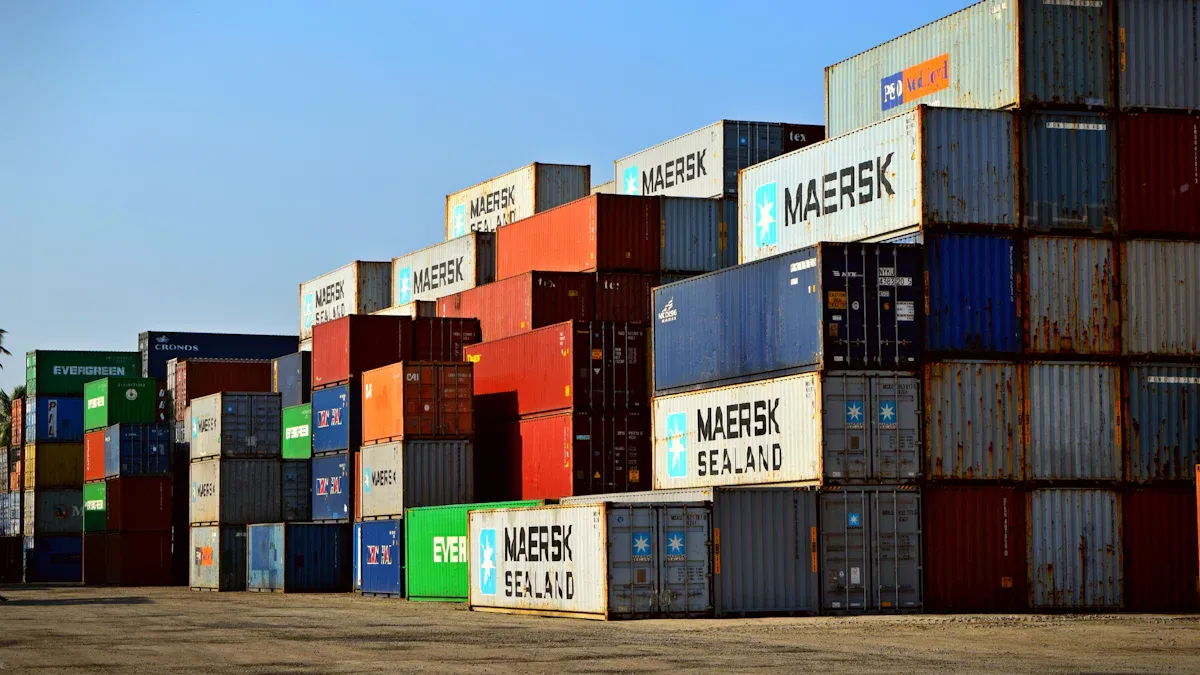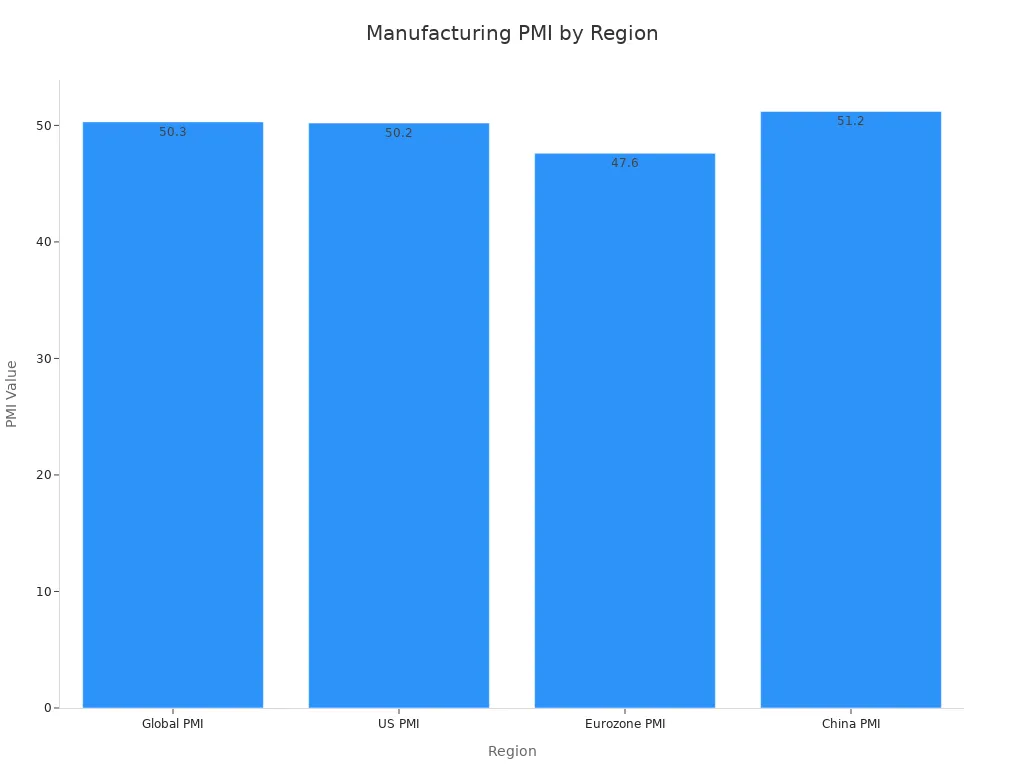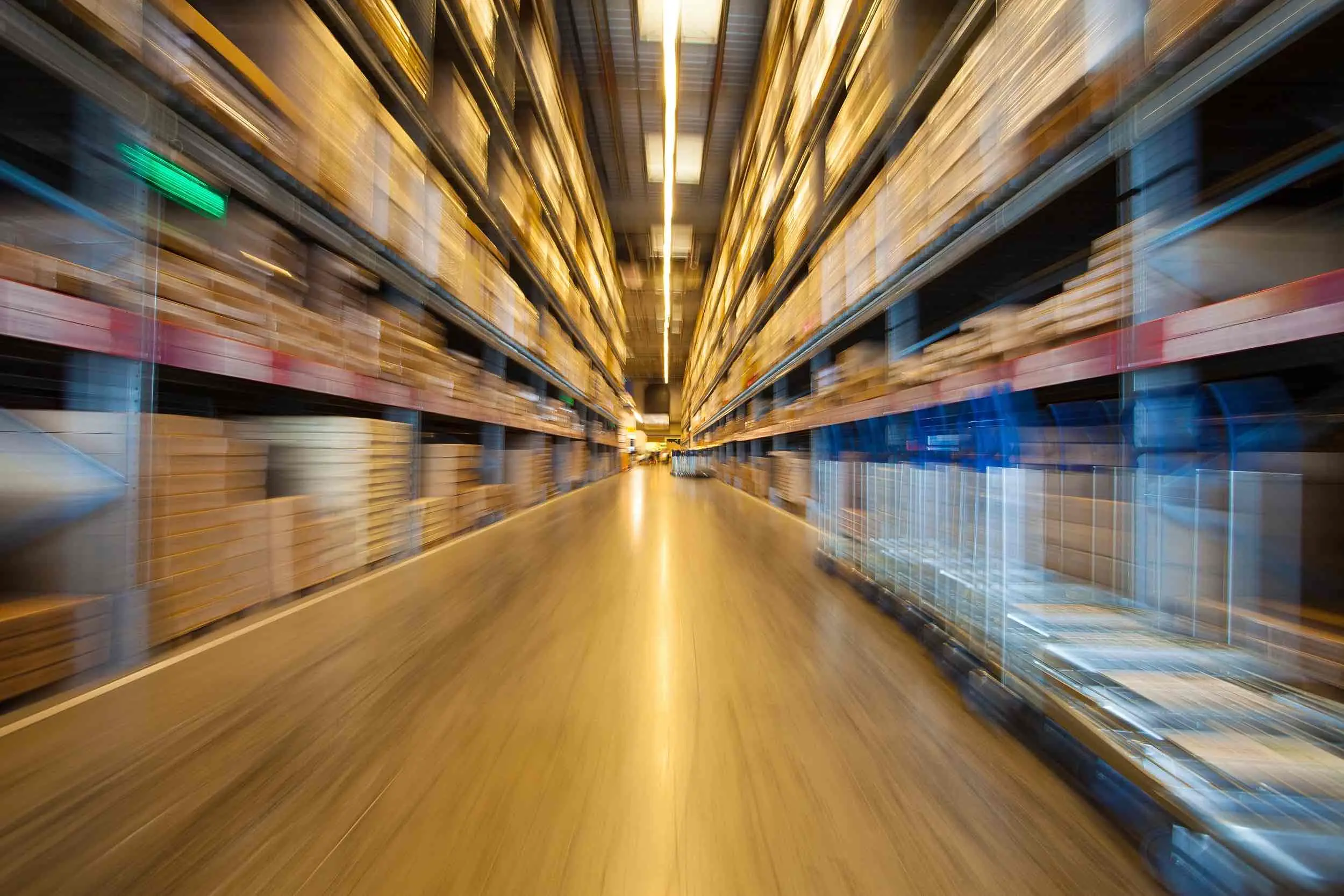Emerging Trends in Overseas Logistics Transportation in 2025

Understanding overseas logistics transportation means keeping up with changing trends. By 2025, shipping needs may grow by 3% to 4%. Ocean shipping alone could rise by 3%. These numbers show businesses must adjust fast to handle global trade well.
Key Takeaways
AI and robots are changing logistics by making work faster. Companies save time and money using these smart tools.
IoT helps track shipments live, showing where they are. This reduces delays and helps manage stock better.
Eco-friendly methods, like clean shipping and new fuels, are key. Businesses can look good and spend less by being green.
Technological Advancements in Global Logistics Trends

AI-Powered Predictive Analytics and Automation
AI is changing logistics by making tasks faster and smarter. It predicts demand, plans better routes, and cuts costs. For example, UPS saves 10 million gallons of fuel each year using AI. Maersk has lowered fuel costs by 15% and usage by 10%. These tools also speed up deliveries. Amazon has made deliveries 30% faster with AI.
Automation helps by reducing mistakes and improving accuracy. AI tools can cut forecasting errors by half, helping manage inventory better. Automated warehouses lower labor costs by 40%, freeing up resources. These technologies make logistics smoother and help businesses stay competitive.
Evidence Type | Statistic/Impact |
|---|---|
Fuel Consumption Reduction | UPS saves 10 million gallons of fuel yearly. |
Maersk cut fuel costs by 15% and usage by 10%. | |
AI reduces fuel use by over 15% annually. | |
Delivery Speed Improvement | AI shortens delivery times by up to 25%. |
DHL improved on-time deliveries by 15%. | |
Amazon sped up deliveries by 30% using AI. | |
Cost Savings | UPS's AI system saves $300-$400 million yearly. |
Early AI users cut logistics costs by 15%. | |
Automated warehouses reduce labor costs by 40%. |
IoT for Enhanced Supply Chain Visibility
IoT is changing logistics by giving real-time updates on shipments. IoT devices track packages, check conditions, and ensure timely deliveries. This reduces delays, theft, and waste while improving teamwork. For example, IoT helps avoid stockouts and keeps inventory organized.
IoT gives better control over logistics. Sensors provide data to make smart decisions. This transparency builds trust with partners and customers. IoT is a key tool for logistics in 2025.
Fewer delivery delays.
Less theft and waste.
Better inventory management.
Stronger teamwork among supply chain partners.
Blockchain for Secure and Transparent Logistics
Blockchain makes logistics safer and more open. It records every transaction on a shared ledger. Everyone in the supply chain sees the same data. This reduces fraud and ensures data is trustworthy.
Blockchain also helps track products in real time. You can follow items from start to finish. This is useful for industries like food and medicine that need strict rules. As blockchain grows, it will shape the future of logistics.
Transactions are recorded on a shared ledger for transparency.
Blockchain ensures data is reliable and reduces fraud risks.
Autonomous Shipping and Drone Innovations
Autonomous ships and drones are exciting changes in logistics. Self-driving ships work nonstop, cutting travel times by 20%. They use smart navigation to plan better and deliver faster. This means quicker and more reliable shipping.
Drones are also transforming logistics. The cargo drone market could grow from $1.06 billion in 2023 to $22.97 billion by 2033. Companies like Amazon and Google have tested drones for deliveries. Drones lower labor costs and improve efficiency. These technologies are becoming essential in modern logistics.
The cargo drone market may grow from $1.06 billion in 2023 to $22.97 billion by 2033.
Drone logistics was worth $7.2 billion in 2023 and is growing fast.
Drones cut labor costs and improve warehouse efficiency.
Tests by Amazon and Google show drones' potential in logistics.
Sustainability and Market Trends in Logistics

Green Shipping Practices and Carbon Neutrality Goals
Green shipping is a big focus for logistics in 2025. Companies are using eco-friendly methods to cut carbon emissions. Governments are making stricter rules to lower pollution. This forces companies to find new ways to ship goods. For example, slow steaming, where ships go slower to save fuel, cut CO2 emissions by 11% in 2011. Small changes like this can make a big difference.
The green logistics market could grow from $164.5 billion in 2023 to $332.4 billion by 2032. This is because people want greener options and companies aim for sustainability. Using green shipping can improve your brand image and save money by being more efficient.
Year | CO2 Emissions Change | Notes |
|---|---|---|
2011 | -11% | Slow steaming reduced emissions from containerships significantly. |
2020 | -10% | COVID-19 disruptions temporarily lowered shipping emissions. |
2021 | +5% | Emissions rebounded as seaborne trade increased. |
Alternative Fuels Revolutionizing Global Transportation and Logistics
New fuels are changing how goods are transported worldwide. Electric vehicles (EVs) and biofuels are becoming popular for cutting pollution. Rules and customer demand are speeding up their use. Many companies are switching to EV fleets to meet emission rules and save money.
This change is a chance to follow trends and work better. New ideas like hydrogen fuel cells and renewable energy are also shaping logistics. Using these technologies helps you stay competitive and support a greener future.
Circular Economy Models in Supply Chain Management
Circular economy models are changing supply chains. These models focus on reusing, recycling, and reducing waste. For example, food companies are using reverse logistics and better packaging to lower their environmental impact. These methods save money and open doors for new ideas.
Key measures like less food waste and better energy use show the value of circular models. Adding these ideas to your supply chain can help you stay sustainable and meet customer demands for eco-friendly products.
Operational Innovations in Overseas Logistics Transportation
Last-Mile Delivery Solutions for Cross-Border E-Commerce
E-commerce growth has changed how goods are delivered worldwide. The last step of delivery is now a major focus. Cross-border shopping needs faster and cheaper delivery options. Companies use smart tools like AI and IoT to improve this process. These technologies help plan better routes, avoid delays, and make customers happier.
Key measures show how well these solutions work:
Measure | What It Means |
|---|---|
On-Time Delivery Rate | Percentage of packages arriving on or before the promised date. |
Delivery Accuracy | Ensures the right items reach the correct addresses. |
Cost Per Package | Tracks the cost of delivering each package to find savings. |
Customer Feedback Score | Shows how happy customers are with their delivery experience. |
Delivery Time Consistency | Measures how steady arrival times are, showing efficiency. |
ePOD Features | Collects signatures, photos, and GPS data for better trust and accountability. |
These tools are changing how cross-border deliveries are done. By focusing on accuracy and speed, businesses can meet e-commerce demands while saving money.
Dynamic Routing and Optimization for Cost Efficiency
Dynamic routing is making deliveries smarter and cheaper. It uses AI to adjust routes based on traffic, weather, and priorities. This saves money and helps the environment.
Companies save up to 25% on delivery costs with dynamic routing.
Optimized routes cut CO2 emissions by 30%.
Better routes mean less time driving and lower fuel use.
For instance, TrackoMile’s software has cut transport costs by 10-15%. Other benefits include:
Benefit | |
|---|---|
Lower Fuel Costs | Up to 30% |
Faster Deliveries | 25% |
Total Route Savings | 10% - 30% |
Dynamic routing improves delivery times and vehicle use. Using it can help businesses stay efficient and competitive.
Collaborative Platforms for Shared Resources
Sharing resources is becoming key in logistics. Platforms let companies work together to save money and improve operations. These tools boost communication, transparency, and teamwork.
Advantage | What It Does |
|---|---|
Better Supply Chain Control | Helps companies access services and improve logistics tasks. |
Lower Transaction Costs | Sharing resources makes storage and transport cheaper. |
Stronger Community Ties | Encourages knowledge sharing and teamwork among partners. |
New Partnerships | Creates direct channels and opens new markets through shared goals. |
Sharing information and making decisions together are big benefits. This teamwork helps businesses adapt to market changes and succeed.
JUSDA’s Warehouse Solutions Enhancing Supply Chain Efficiency
JUSDA offers advanced warehouse solutions to improve supply chains. With over 2.5 million square meters of space, they use smart tools like RFID and WMS for better control. These systems improve inventory tracking, reduce delays, and make operations more flexible.
Feature | What It Offers |
|---|---|
Full-Service Coverage | Handles everything from warehousing to distribution for smooth operations. |
Smart Technology | Uses tools like RFID and WMS for accurate and efficient management. |
Customer-Focused Solutions | Designs services for industries like electronics and cars to meet specific needs. |
Local Market Strategies | Works in key areas like North America and Vietnam to improve response times. |
Digital Tools | Offers real-time tracking and dynamic inventory management for better control. |
JUSDA helps businesses simplify logistics with smart tools and a customer-first approach. Their solutions boost efficiency and flexibility in global markets.
Macroeconomic and Regulatory Factors Impacting Logistics Trends
Geopolitical Tensions and Their Effect on Trade Routes
Conflicts between countries are changing shipping and logistics. Disputes cause blocked routes, making companies find new paths. This leads to crowded ports and higher shipping prices. Freight costs from Asia to Europe have nearly tripled. Fuel prices also change often, raising transportation expenses.
Insurance costs are rising in risky areas due to safety concerns. New trade rules make shipping harder and more expensive. Businesses need smart plans to stay efficient and avoid losing money.
Evidence Type | Description |
|---|---|
Freight Rate Increase | Freight costs from Asia to Europe have nearly tripled. |
Increased Insurance Premiums | Insurance costs are higher in unsafe areas. |
Fuel Price Volatility | Changing fuel prices raise shipping costs. |
Rerouting and Capacity Strain | New routes cause crowded ports and higher costs. |
Regulatory Compliance Costs | Trade rules make shipping harder and more costly. |
Evolving Customs Regulations and Compliance Challenges
Customs rules are getting harder to follow, causing delays. Companies must deal with different rules in many regions. This raises costs and slows down shipments. The World Bank says better trade systems can cut costs by 15%. This shows how customs rules affect global shipping.
To handle this, businesses need tools to track customs rules. Real-time updates and teamwork tools can make processes faster and safer.
Customs rules are harder to follow, causing delays and costs.
Better trade systems can lower costs by 15%, says the World Bank.
Global Economic Trends Driving Freight Demand
Economic changes affect shipping needs. Manufacturing, retail, and industry growth increase demand for freight. For example, China’s manufacturing activity grew to 51.2, showing strong progress. In contrast, the US manufacturing rate dropped to 50.2, showing slower growth.
Inflation also impacts shipping costs. Global inflation rose to 3.51%, while US inflation reached 3.2%. These changes affect buying power and shipping demand worldwide.
Indicator | Value | Change from Previous Projection |
|---|---|---|
Global GDP Forecast | Flat | - |
Retail Sales Forecast | 1.57% | Increased from December |
Industrial Production Forecast | 2.01% | Slight increase |
Global Manufacturing PMI | 50.3 | Decreased from 50.6 |
US Manufacturing PMI | 50.2 | Fell from 52.7 |
Eurozone PMI | 47.6 | Flat, output increased |
China’s Manufacturing PMI | 51.2 | Increased from sustained growth |
3.51% | Increased from 3.41% | |
US Inflation Rate Forecast | 3.2% | Increased from 2.85% |
Chinese Inflation Rate | 0.57% | Revised down from 0.9% |

Government Incentives for Sustainable Logistics Practices
Governments are helping businesses use eco-friendly shipping methods. Tax breaks and money rewards encourage green practices. These programs aim to cut pollution and save energy.
For example, grants are given for electric trucks and clean energy. These rewards lower costs and help the environment. By using these programs, companies can improve their image and follow global trends.

JUSDA Solutions
To provide you with professional solutions and quotations.
The future of overseas logistics transportation in 2025 focuses on new ideas, eco-friendly methods, and flexibility. To stay ahead, businesses must follow these trends. Tools like JUSDA’s warehouse services improve supply chains and make them stronger. By acting early, companies can handle problems and use new solutions for lasting success.
Key Trends and Benefits
The table below shows how new logistics trends help businesses stay strong and competitive:
Key Trends in Logistics | How They Help Businesses | Long-term Advantages |
|---|---|---|
Better logistics systems | Boosts trade growth | Makes trade easier for countries |
Spotting new trends | Solves supply chain problems | Lowers shipping costs |
Advice from top industry experts | Opens doors for growth | Encourages global trade |
Learning about transportation changes in 2025 helps businesses stay strong in a fast-changing world.
See Also
Five Key Trends Shaping Future Supply Chain Effectiveness
Discovering Innovations in Sea Freight Logistics for 2024
Understanding Current Trends in Logistics Risk Management
Get Prepared: New Transport Technologies Transforming Supply Chains
